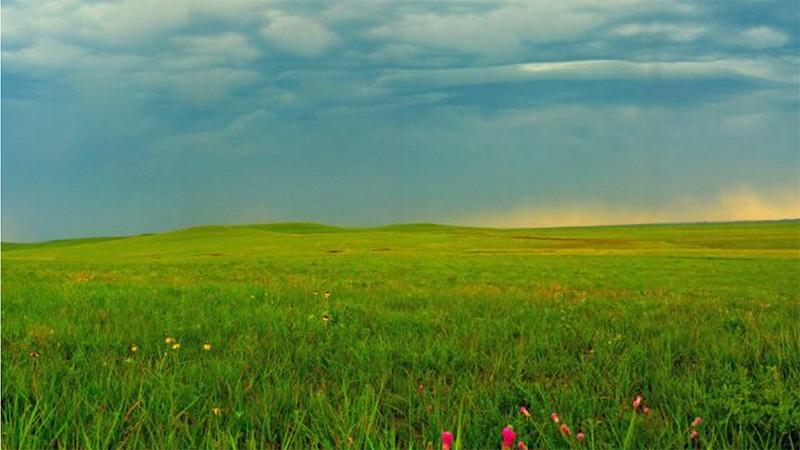View your homeland with different eyes.
Some little known and even surprising facts…a regular feature the Mission Times.
Kansas is named for the people who lived in our homeland centuries before the settlers arrived. Their name is taken from the south winds that still blow across the land today. These ‘wind people’ believe in the power of the wind. According to the Kaw Nation Learning Center, “The Southwind travels far and fast and knows the movements of the buffalo and other foragers. The wind conducts reconnaissance on enemies and carries messages to and from allies. The wind knows where nuts, fruits, and grains grow and the hiding places of squirrel, rabbit, and turkey. And so, the Kaw (Kanza) lived long with the Southwind and the Southwind with them.” Our home was the homeland of the Koin-Za (phoneticized by the French as Kanza). These are the people who have given their name to Kansas.
In the 1400’s aboriginal people sharing the Dhegiha language began to divide to better serve their people as their populations grew. These smaller groups, the Kanza, Osage, Omaha, Ponca and Quapaw lived along the Ohio and Wabash Rivers and were believed to be involved in what is now known as Cahokia. Late in the 15th century they began to migrate west, each going their own way. The Omaha and Quapaw became independent groups migrating to northern Missouri and Arkansas respectively. The Kanza, Osage and Ponca followed the Missouri River west; the Ponca traveling toward the Black Hills and the Kanza and Osage heading farther along the Missouri until they came to its juncture with the Kansas River. There, the Osage headed south and the Kanza went west and north establishing their territory in what is now Northern Kansas.
In the 1500’s Francisco Vasquez de Coronado and a priest traveling with him documented contact with the Kanza people. In the 1600’s Spanish explorers encountered the Kanza who were referenced in his journal as “A wild and Powerful tribe who were out on their annual raid to plunder the cultivated country of the Quivirans (Pawnee)”. Kanza traded furs with the French in the 1600’s and explorers Louis Jolliet and Jacques Marquette placed a Kanza village on the 39th parallel. Kansas City is on the 39th parallel.
In the 1700’s frequent accounts by explorers estimated that 1,500 Kanza families lived along the Kansas River. Reports in 1723 mention a large settlement of Kanza Indians on the Big Blue River, just east of the confluence of the Missouri and the Kansas River. The British worked treacherously to break the connection between the Kanza and the French Chouteau family. The Kanza and Osage fought a 12-year war until Zebulon Pike helped establish peace.
In June 1804 Lewis and Clark discovered a Kanza Village at the juncture of the Kansas and Missouri Rivers. It was believed that the tribe had temporarily gone west to hunt bison The Kaw homeland, and now ours, looked very different than it does now. According to the Friends of the Kaw, “On the day the explorers first saw the Kansas, Clark wrote that they had encountered “a great number of Parrot queets.” The now extinct Carolina Parakeet inhabited the eastern part of the United States at that time. It moved about in compact flocks often numbering hundreds. Lewis and Clark were the first to record the presence of this colorful bird west of the Mississippi. They saw their first buffalo…”
Ethnobotanist Kelly Kindsher describes the Douglas County of the past, “Prior to settlement, the area was inhabited by the Kansa and other Native American tribes. Approximately 87% of the county was originally native prairie, a diverse mix of native grasses and wildflowers, which was primarily maintained by fires either set by Native Americans or started by lightning. The remaining land was primarily forest, but there were also smaller areas of wetland and marsh. Forested lands were limited to places naturally protected from fire with moist soils in riparian areas along streams and rivers, and steep, moist, north-facing, sometimes rocky, slopes…” The tall grass prairie looked like an ocean of waving grass and blooms blown by the south winds.
The prairie, North America’s predominant pre-settlement landscape feature, has been diminished to less than 4% of what it was before settlers arrived. But the south winds remain. Many in the Kaw Nation today still feel the draw of home to the state that bears their name. When you are taking a walk or sitting outside and the south winds blow on your face, remember the people who called this ‘home’ long before those who call it home today…the Kanza, people of the south winds. We share this feeling of homeland with them.

